What is Cocoa Beans
Do you like chocolate? Most people do.
The smooth, brown candy is deliciously sweet.
Not all chocolate tastes exactly alike, but it all tastes like chocolate, doesn’t it?
That’s because it all comes from the cocoa bean.

WHAT IS A COCOA BEAN
Cocoa beans are little beans found in the pods that grow on cacao (cocoa) trees. The pods are orange and are about as big as a small pumpkin. They look like a football with some of the air out of it.
When the pods are ready to be picked, they are cut open so the beans inside can be taken out and roasted (baked). Before the cocoa bean is roasted, it has over three hundred different flavors.
Roasting the beans dries them so they can be crushed into cocoa (chocolate powder). So I guess you can say chocolate grows on trees…sort of. Plain cocoa is very bitter. It’s not really chocolate until you add sugar.

GROWING COCOA BEANS
Since cocoa beans grow on trees, you might be thinking you want to plant a few in your yard. Unless you live in South America or somewhere else south of the Equator, you won’t be able to. That’s because cocoa trees only grow in climates where it is hot and humid all year long. Cocoa trees need neat and humidity, but they do not grow well unless they are planted near taller trees that will help shade them from the direct sun. That is why most people who grow cocoa trees also grow mangos or papayas. This works well because both of these fruits need the same kind of weather and soil.
Cocoa trees grow slowly. It takes three to five years for cocoa trees to produce pods with beans for making chocolate. Cocoa trees can live up to two hundred years, but will only produce cocoa beans for about twenty-five of those years.
A tree produces about one thousand cocoa beans every year. That is enough to make about two pounds of chocolate.

THINK ABOUT THIS…
Every year, people all over the world eat or drink 2 BILLION (1000000000) pounds of chocolate every year. So…if every cocoa tree produces enough beans to make only 2 pounds of chocolate a year, 1 BILLION cocoa trees are needed every year to keep the world supplied in chocolate.
THE FIRST CHOCOLATE
The Mayan Indians were the first people we know of to use chocolate. They crushed the beans into powder and mixed it with water for…HOT CHOCLATE. They called it ‘bitter water’ because they did not put sugar in it.
The Mayans even used cocoa beans for money. Mayan Indians used cocoa beans to buy slaves and animals.
OTHER INTERESTING FACTS ABOUT COCOA
- Chocolate is the number one use for cocoa beans, but it isn’t the only thing they are good for. Cocoa beans can also be used for…
- The oil taken from cocoa beans before they are roasted is called cocoa butter. It is used to make chocolate and many other food items.
- Some animals like to eat cocoa bean hulls.
- The hulls from the cocoa beans are used as mulch. Mulch is what people put around trees and in flower beds to keep the weeds from growing.
- Cocoa is not used to make white chocolate.
How Coboa beans are Harvested Into Chocolate
Chocolate is the greatest gift the Earth has given us. The dessert table would be a sad sight without it. It’s so beloved, so appreciated, that the Swedish scientist who named the cocoa plant that gives us chocolate called it Theobroma cacao, which means “food of the gods.”
Anyone who loves chocolate knows this is absolutely fitting, mostly because it is the most delicious stuff on earth, but also because of the incredible process and long journey it has to undergo to become the sweet confection we adore.
Chocolate starts off as cocoa pods growing in the tropics, typically in a belt around the equator, long before showing up at a local grocery store near you. Here it is in its humble beginnings as a pod on the tree:

Red cocoa pods ripening on a cocoa tree.
Cocoa pods grow in a variety of colors ― red, green or purple ― but they all ripen into the yellowish color shown below. They grow directly off of the branch of the tree, which makes them easy to harvest because they’re easy to reach. Unlike cherries or peaches, cocoa pods don’t necessarily ripen all at once on many farms and can be harvested at regular intervals.
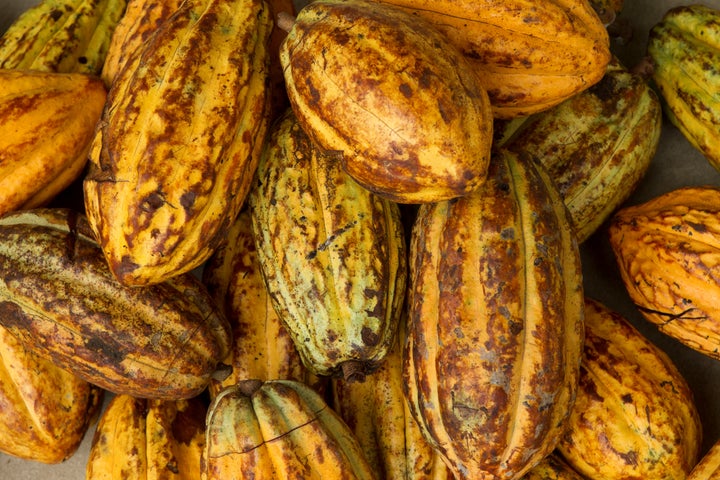
According to the International Cocoa Organization, cocoa pods must be harvested manually with care so as not to damage the junction of the stem to the tree; keeping this joint intact by using a curved knife during harvesting ensures the growth of more fruit.
Each tree can yield about 20-30 pods per year, and it takes one tree’s entire annual harvest to make roughly a pound of chocolate.
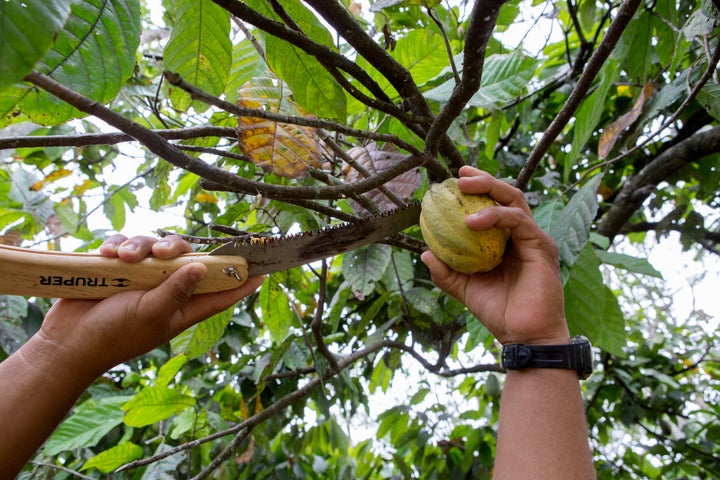
Once harvested, the cocoa pod is cracked open and the rind is discarded; the pulp and seed pods are what farmers are after. There are about 30-50 seeds per pod, and these are responsible for making the chocolate we love. It’s hard to imagine from the way they look in their raw form.
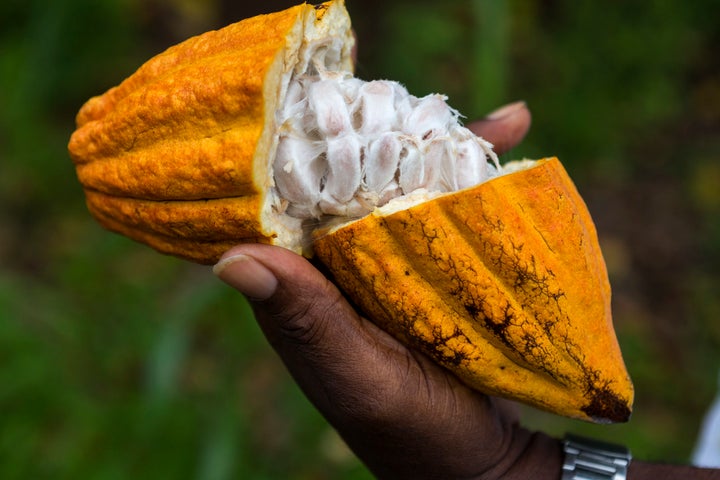
Next, the seeds and pulp are left to ferment. Amano Chocolate, a gourmet chocolatier, explains that fermentation helps bring out the desired flavors of the cocoa, and it adds a body and richness that unfermented beans lack. It also tames the cocoa seed’s bitterness by reducing the amount of tannins found in the beans thanks to cellular changes that occur during the process.
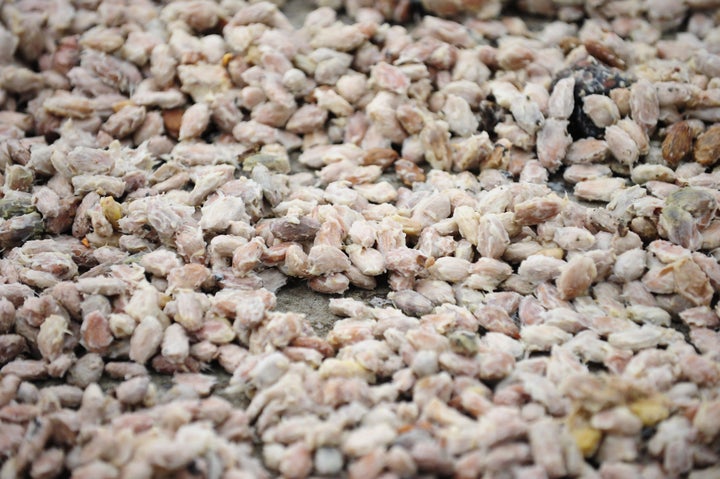
Fermentation often happens in sweatboxes and takes about two to eight days. During fermentation the pulp is converted into alcohol, which according to Ecole Chocolat turns into lactic and acetic acid when mixed with air. This essentially ensures that the beans will not germinate, which would make the bean unusable. During fermentation, the sticky pulp turns to liquid and drains off on its own, and just the bean is left behind and ready to be dried.
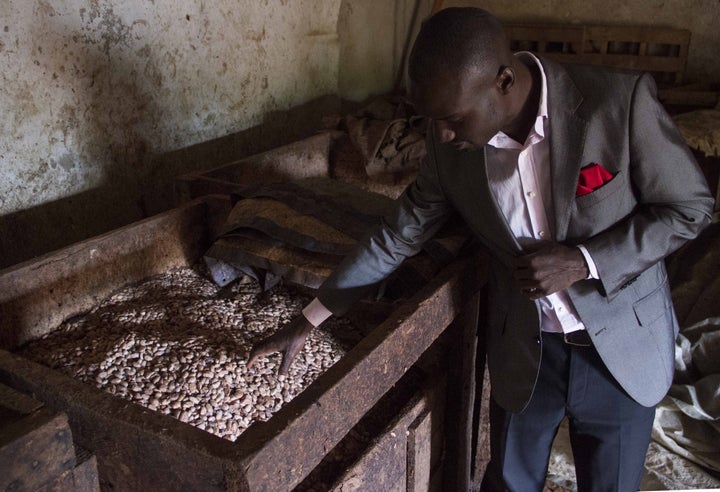
According to the ICCO, the best way to dry the beans is in the sun, though artificial drying does occur in places where the climate makes it necessary. It is important that they are properly dried ― bringing them from 60 percent moisture to under 10 percent ― to ensure the beans don’t rot. Drying takes on average five to six days.
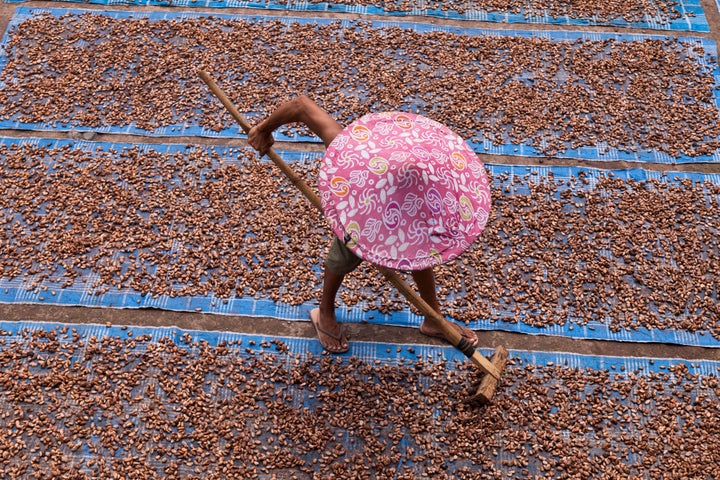
Once dried, the cocoa beans that were once wet, sticky and purple-white-ish in tone have become a beautiful red-brown color. They are then packed and ready to ship to chocolate manufacturers all over the world.
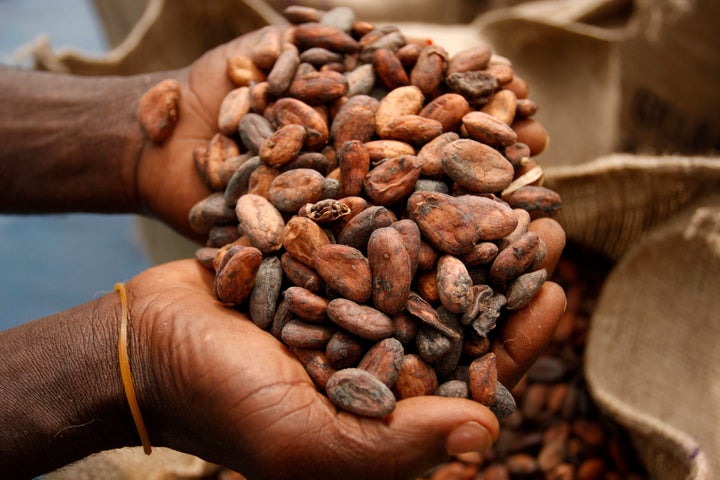
Just like with coffee beans, cocoa has to be roasted before being used. Armano Chocolate explains that roasting further brings out the flavor of chocolate from the bean. The time and temperature of roasting depends on the flavors the chocolate manufacturer wants to extract. It’s during roasting that the beans are cracked, the hulls discarded and the “meat of the cocoa” is crushed and taken aside to be made into chocolate.
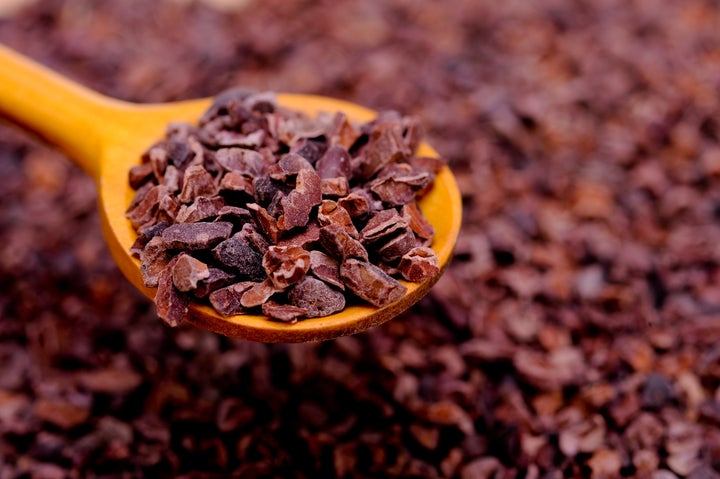
Cocoa nibs.
But if they continue on the chocolate journey, the cocoa nibs must be pressed into what’s known as cocoa liquor, even though there is no alcohol in it. This liquid can be turned into many different chocolate confections with the addition of sugar and other ingredients. It can also be further processed into two components: cocoa solids and cocoa butter, which you can see below.

One reason the liquor is turned into either solids or butter or is to create chocolate beverages with solids ground into cocoa powder, which benefits from a lower fat content. Another is to make white chocolate ― which actually uses no chocolate liquor ― with the cocoa butter. The cocoa butter is also reserved to be put back into chocolate. It’s what gives chocolate its smooth mouthfeel. But some chocolate producers sell the cocoa butter to be used in cosmetics and other applications, replacing it in chocolate with vegetable oils. Unfortunately, this produces inferior chocolate.
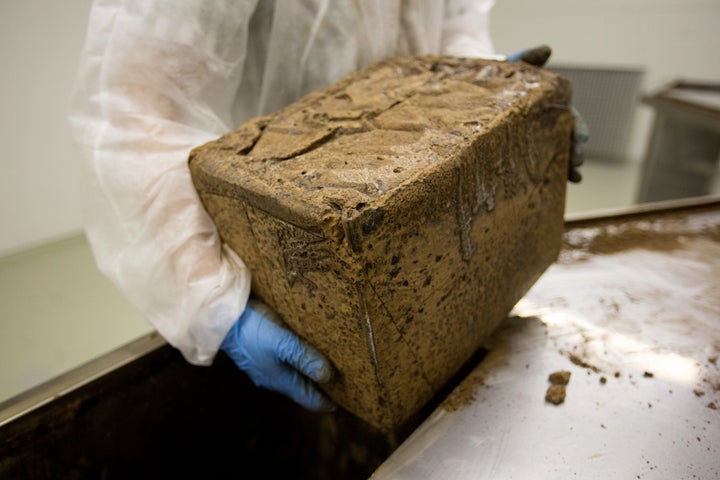
Compressed cocoa powder at a plant in Russia.
Some chocolate producers will make chocolate from cocoa solids, cocoa butter, sugar and an emulsifier like soy lecithin. When done right, it looks like this beautiful sight below.
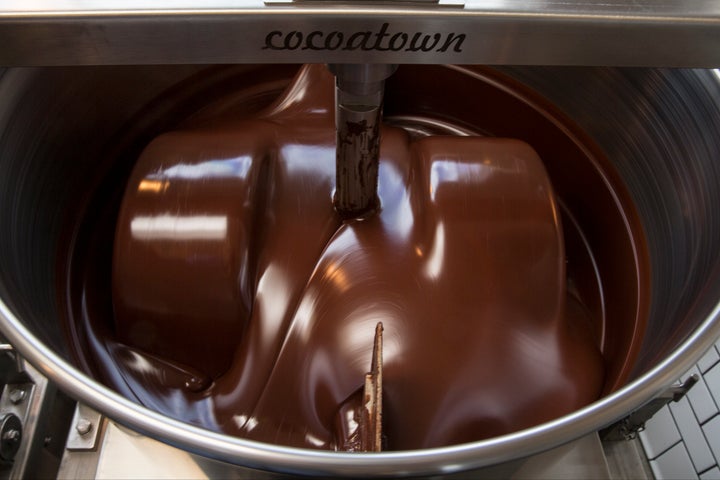
That dreamy liquid chocolate is then molded, packaged and shipped to stores near you.